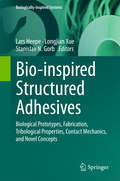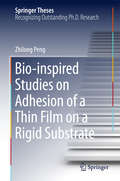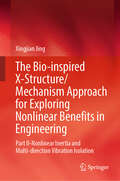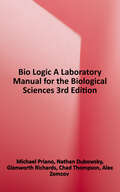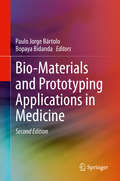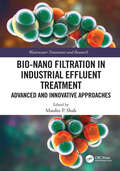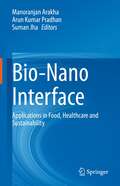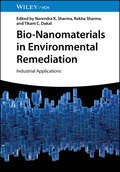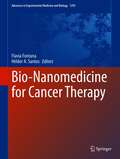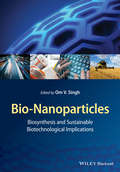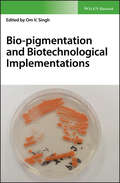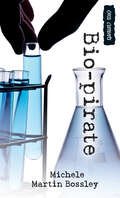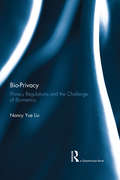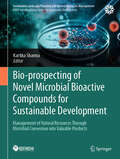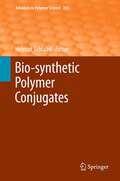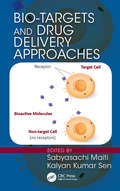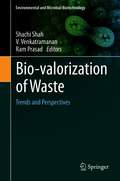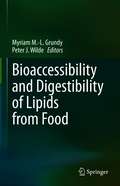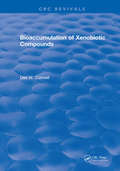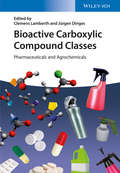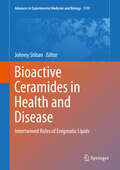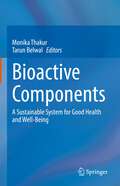- Table View
- List View
Bio-inspired Structured Adhesives: Biological Prototypes, Fabrication, Tribological Properties, Contact Mechanics, and Novel Concepts (Biologically-Inspired Systems #9)
by Stanislav N. Gorb Lars Heepe Longjian XueThis book deals with the adhesion, friction and contact mechanics of living organisms. Further, it presents the remarkable adhesive abilities of the living organisms which inspired the design of novel micro- and nanostructured adhesives that can be used in various applications, such as climbing robots, reusable tapes, and biomedical bandages. The technologies for both the synthesis and construction of bio-inspired adhesive micro- and nanostructures, as well as their performance, are discussed in detail. Representatives of several animal groups, such as insects, spiders, tree frogs, and lizards, are able to walk on (and therefore attach to) tilted, vertical surfaces, and even ceilings in different environments. Studies have demonstrated that their highly specialized micro- and nanostructures, in combination with particular surface chemistries, are responsible for this impressive and reversible adhesion. These structures can maximize the formation of large effective contact areas on surfaces of varying roughness and chemical composition under different environmental conditions.
Bio-inspired Studies on Adhesion of a Thin Film on a Rigid Substrate (Springer Theses)
by Zhilong PengThe thesis systematically investigates the factors which influence many animals' robust adhesion abilities and micro-reversible adhesion mechanisms, including the geometric principles of their adhesion, relative humidity, surface roughness and pre-tension. Studies exploring biological adhesion mechanisms are not only of great significance for the design of advanced adhesive materials and adhesion systems for micro-climbing robots, but also very helpful for resolving the problem of adhesion failure in MEMS/NEMS.
The Bio-inspired X-Structure/Mechanism Approach for Exploring Nonlinear Benefits in Engineering: Part I-Nonlinear Stiffness and Nonlinear Damping
by Xingjian JingThis book presents a unique approach to the design and analysis of beneficial nonlinearity, which can take an important and critical role in engineering systems and thus cannot be simply ignored in structural design, dynamic response analysis, and parameter selection. A key issue in the area is thus systematically addressed about how to analyze and design potential nonlinearities introduced to or inherent in a system, which is a must-do task in many practical applications involving vibration control, energy harvesting, sensor systems and robots, etc. This book, therefore, presents an up-to-date summary on the most recent development of a cutting-edge method for nonlinearity manipulation and employment developed in recent several years, known as the X-shaped structure or mechanism approach. The method is inspired from animal leg/limb skeletons and can provide passive low-cost high-efficiency adjustable and beneficial nonlinear stiffness (high static and ultra-low dynamic), nonlinear damping (dependent on resonant frequency and vibration excitation amplitude), and nonlinear inertia (low static and high dynamic) individually or simultaneously. The X-shaped structure or mechanism is a generic structure or mechanism representing a class of beneficial geometric nonlinearity with realizable and flexible linkage mechanism or structural design of different variants or forms (quadrilateral, diamond, polygon, K/Z/S/V/A/W-shape, or others) which all share similar geometric nonlinearity and thus similar nonlinear stiffness/damping properties, flexible in design, and easy to implement. This book systematically introduces the research background, motivation, essential bio-inspired ideas, advantages of this novel method, beneficial nonlinear properties in stiffness, damping and inertia, associated theory for analysis and design of nonlinear dynamics, potential applications and case studies, most of which have been developed ever since 2010. This is Part I of this book series, and the results in this book focus on beneficial nonlinear stiffness and damping characteristics of the fundamental X-shaped structure/mechanism and its variants, and provide an in-depth understanding of potential nonlinear properties that can be achieved through passive structural/mechanism designs via this class of X-structures or mechanisms.
The Bio-inspired X-Structure/Mechanism Approach for Exploring Nonlinear Benefits in Engineering: Part II-Nonlinear Inertia and Multi-direction Vibration Isolation
by Xingjian JingThis book presents a unique approach to the design and analysis of beneficial nonlinearity, which can take an important and critical role in engineering systems and thus cannot be simply ignored in structural design, dynamic response analysis, and parameter selection. A key issue in the area is thus systematically addressed about how to analyze and design potential nonlinearities introduced to or inherent in a system of under study, which is a must-do task in many practical applications involving vibration control, energy harvesting, sensor systems and robots, etc. This book, therefore, presents an up-to-date summary on the most recent development of a cutting-edge method for nonlinearity manipulation and employment developed in recent several years, named as the X-shaped structure or mechanism approach. The method is inspired from animal leg/limb skeletons and can provide passive low-cost high-efficiency adjustable and beneficial nonlinear stiffness (high static and ultra-low dynamic), nonlinear damping (dependent on resonant frequency and vibration excitation amplitude) and nonlinear inertia (low static and high dynamic) individually or simultaneously. The X-shaped structure or mechanism is a generic structure or mechanism representing a class of beneficial geometric nonlinearity with realizable and flexible linkage mechanism or structural design of different variants or forms (quadrilateral, diamond, polygon, K/Z/S/V-shape, or others) which all share similar geometric nonlinearity and thus similar nonlinear stiffness/damping properties, flexible in design, and easy to implement. This book systematically reviews the research background, motivation, essential bio-inspired ideas, advantages of this novel method, beneficial nonlinear properties in stiffness, damping and inertia, and potential applications, which have been developed ever since 2010. This book reveals important nonlinear properties and dynamic characteristics of nonlinear inertia that can be provided through the X-structure/mechanism and also presents advantageous features of X-structure/mechanism methods in multi-direction vibration control.
Bio Logic: A Laboratory Manual for the Biological Sciences
by Michael Priano Nathan Dubowsky Glenworth Richards Chad Thompson Alex ZemcovWith this laboratory manual, students can assume the role of the biological scientist as they observe the phenomena of life and life processes. Students will develop generalizations to explain observations. They will confirm, modify, or reject generalizations as they continue to make predictions and collect additional observations as they experience how science"works." With some effort, this laboratory manual, and the sage advice of a laboratory instructor, the time spent in these efforts will prove to be most interesting and intellectually rewarding.
Bio-Materials and Prototyping Applications in Medicine
by Paulo Jorge Bártolo Bopaya BidandaRapid prototyping is used to design and develop medical devices and instrumentation. This book details research in rapid prototyping of bio-materials for medical applications. It provides a wide variety of examples of medical applications using rapid prototyping, including tissue engineering, dental applications, and bone replacement. Coverage also discusses the emergence of computer aided design in the development of prosthetic devices.
Bio-MEMS: Technologies and Applications
by Wanjun Wang Steven A. SoperThis book considers both the unique characteristics of biological samples and the challenges of microscale engineering. Divided into three main sections, it first examines fabrication technologies using non-silicon processes, which are suitable for the materials more commonly used in medical/biological analyses. These include UV lithography, LIGA, nanoimprinting, and hot embossing. Attention then shifts to microfluidic components and sensing technologies for sample preparation, delivery, and analysis in microchannels and microchambers. The final section outlines various applications and systems at the leading edge of Bio-MEMS technology in a variety of areas such as drug delivery and proteomics.
Bio Monomers for Green Polymeric Composite Materials
by Visakh P. M. Oguz BayraktarPresents new and innovative bio-based monomers to replace traditional petrochemical-based building blocks Featuring contributions from top experts in the field, this book discusses new developments in the area of bio monomers and green polymeric composite materials. It covers bio monomers, green polymeric composites, composites from renewable resources, bio-sourced polymers, green composites, biodegradation, processing methods, green polymeric gels, and green polymeric membranes. Each chapter in Bio Monomers for Green Polymeric Composites Materials presents the most recent research and technological ideas in a comprehensive style. It examines bio monomers for green polymer and the processing methods for the bio nanocomposites. It covers the preparation, characterization, and applications of bio-polymeric materials based blends, as well as the applications of biopolymeric gels in medical biotechnology. The book also explores the properties and applications of gelatins, pectins, and carrageenans gels. Additionally, it offers a plethora of information on green polymeric membranes; the bio-degradation of green polymeric composites materials; applications of green polymeric composites materials; hydrogels used for biomedical applications; and the use of natural aerogels as thermal insulations. Introduces readers to the innovative, new bio-based monomers that are taking the place of traditional petrochemical-based building blocks Covers green polymers, green composites, bio-sourced polymers, bio nanocomposites, biodegradable polymers, green polymer gels, and membranes Features input from leading researchers immersed in the area of study Bio Monomers for Green Polymeric Composites Materials is suitable for academics, researchers, scientists, engineers and advanced students in the field of bio monomers and green polymeric composites materials.
Bio-Nano Filtration in Industrial Effluent Treatment: Advanced and Innovative Approaches (Wastewater Treatment and Research)
by Maulin P. ShahThe ever-increasing number of pollutants discharged into the environment drives the search for new treatment technologies or the modification of the existing ones. In this sense, innovation in bio-nano filtration systems seems very promising and, therefore, a book on the current advances and innovations on this topic is highly appropriate. Bio-nano filtration is a relatively new emerging technology applied to the treatment of wastewater and other toxic compounds. In the last two decades, this technology has begun to emerge as an economically viable process to treat the great variety of recalcitrant pollutants discharged into the environment. Thus, it is speculated that the US biofiltration market will reach over $100 million by 2020. This book aims to present how innovation in bio-nano filtration can provide effective solutions to overcome the serious problem of water pollution worldwide. The removal of contaminants will be the result of the combined effects of biological oxidation, adsorption, and filtration processes. Features: Describes the microbial ecology of bio-nano filtration. Describes the modelling of bio-nano filtration. Describes the design of bio-nanofillers.
Bio-Nano Interface: Applications in Food, Healthcare and Sustainability
by Manoranjan Arakha Arun Kumar Pradhan Suman JhaThis book discusses the unique interactions of nanoparticles with various biomolecules under different environmental conditions. It describes the consequences of these interactions on other biological aspects like flora and fauna of the niche, cell proliferation, etc. The book provides information about the novel and eco-friendly nanoparticle synthesis methods, such as continuous synthesis of nanoparticles using microbial cells. Additionally, the book discusses nanoparticles' potential impact in different areas of biological sciences like food, medicine, agriculture, and the environment. Due to their advanced physicochemical properties, nanoparticles have revolutionized biomedical and pharmaceutical sciences. Inside the biological milieu, nanoparticles interact with different moieties to adopt stable shape, size, and surface functionalities and form nano-biomolecular complexes. The interaction pattern at the interface form complexes determines the fate of interacting biomolecules and nanoparticles inside the biological system. Understanding the interaction pattern at the nano-bio interface is crucial for the safe use of nanoparticles in natural sciences. This book rightly addresses all questions about the interaction and the ensuing structure and function of these nano-biomolecular complexes. This book caters to students and researchers in the area of biotechnology, microbiology, and pharmaceutical sciences.
Bio-Nanomaterials in Environmental Remediation: Industrial Applications
by Narendra K. Sharma Rekha Sharma Tikam C. DakalReference on using bio-nanomaterials to remove pollution in industrial sectors ranging from food and agriculture to oil and gas Bio-Nanomaterials in Environmental Remediation discusses the application of bio-nanomaterials in various industrial settings. Bio-Nanomaterials in Environmental Remediation includes information on: Fundamentals, classification, and applications of bio-nanomaterials, technologies for the fabrication of bio-nanomaterials, and desalination of wastewater using bio-nanomaterials Applications of bio-nanomaterials in the textiles, oil, gas, food, and agriculture industries Hazard, toxicity, and monitoring standards of bio-nanomaterials Current challenges of bio-nanomaterials in industrial applications and future outlooks in the field Strategies to manage the safety of bio-nanomaterials to enable the creation of healthy and pollution-free environments Bio-Nanomaterials in Environmental Remediation is an essential up-to-date reference for professionals, researchers, and scientists working in fields where bio-nanomaterials are used.
Bio-Nanomedicine for Cancer Therapy (Advances in Experimental Medicine and Biology #1295)
by Flavia Fontana Hélder A. SantosThe book covers the latest developments in biologically-inspired and derived nanomedicine for cancer therapy. The purpose of the book is to illustrate the significance of naturally-mimicking systems for enhancing the dose delivered to the tumor, to improve stability, and prolong the circulation time. Moreover, readers are presented with advanced materials such as adjuvants for immunostimulation in cancer vaccines. The book also provides a comprehensive overview of the current status of academic research. This is an ideal book for students, researchers, and professors working in nanotechnology, cancer, targeted drug delivery, controlled drug release, materials science, and biomaterials as well as companies developing cancer immunotherapy.
Bio-Nanoparticles
by Om V. SinghNanoparticles are considered to be the building blocks for nanotechnology and are referred to as the particles having more than one dimension of the order of 100 nm or less.The nanostructured materials are being offered as better built, long lasting, cleaner, safer, and smarter products for use in communications, medicine, transportation, agriculture and other industries. Topics in molecular recognition, biomolecule-nanocrystal conjugates as fluorescence label for biological cells, and DNA-mediated groupings of nanocrystals are widespread, intriguing researchers from both biological and engineering fields. The diversity of nanotechnology covers fields from biology to material science, physics to chemistry, and other fields with variety of specialties. Controlled size, shape, composition, crystallinity, and structure-dependent properties of nanoparticles govern the unique properties of nanotechnology. The controlled biosynthesis of nanoparticles is of high scientific and technological interest as the microorganisms grab target ions from their environment and then turn the metal ions into the element metal through enzymatic mechanism generated through their cellular (Intra/ Extra) activities. The project aims to introduce the basics and advancements made so far in the field of biosynthesis of nanoparticles for graduate students and researchers around the world. The main aims are to (a) introduce the reader to the variety of microorganisms and their ability to synthesize the nanoparticles, (b) provide an overview of the methodologies applied to biosynthesize the variety of nanoparticles of medical and commercial uses, (c) provide a literature review on diversity of microorganisms able to synthesize nanoparticles of different types, (d) to discuss the regulatory mechanisms in microorganism able to synthesize variety of nanoparticles, (e) discuss experimental design problems associated with the controlled biosynthesis of nanoparticles, (f) discuss the stability and toxicity of nanoparticles in varying environment towards their therapeutic implications. The regulations, challenges and implications of biosynthesized nanoparticles for commercial significance will also represent among the main sections of the book. These aims will be organized by invited research/ review articles from renowned researchers exploring biosynthesis of variety of nanoparticles, and differ in length and number of chapters, with the literature review section containing the bulk of the text.
Bio-pigmentation and Biotechnological Implementations
by Om V. SinghRecent technological advances have provided unique opportunities for the exploration of alternatives to the industrial use of chemically produced synthetic colors. The most promising developments in this area have been in bio-pigmentation derived from microorganisms. This groundbreaking book reviews the current state of the science of bio-pigmentation, providing important insights into the molecular mechanisms of microbial biosynthesis of industrial pigments. Featuring contributions by leading researchers from both industry and academe, it explores the latest advances in the use of bio-pigments as safe, sustainable alternatives to chemically synthesized pigments, and provides extensive coverage the most promising sources of bio-pigments within the food, feed, and pharmaceutical industries. • Proposes microbial uniqueness of coloration in variety of food, feed and pharmaceuticals • Covers the basic science behind bio-pigmentation as well as the latest advances in the field • Describes detection strategies for screening and identifying color producing microorganisms under varying environmental conditions • Provides an exhaustive review of the literature on color producing extremophiles and offers fascinating insights into color production as a stress response in extremophiles • Explores microbial molecular mechanisms of color production, with special coverage of color production as secondary metabolites under environmental stress Bio-pigmentation and Biotechnological Implementations is required reading for professionals and post-doctoral students of microbiology, applied microbiology, food microbiology, food science, and food biochemistry. It is a valuable working resource for scientists working in color-dependent food, feed, and pharmaceuticals.
Bio-pirate (Orca Currents)
by Michele Martin BossleyTrevor, Robyn and Nick decide they have a mystery to solve when Trevor discovers a suspicious looking young man snooping around. They learn about missing research involving the use of carob beans to aid in cancer treatment-potentially valuable information. With a shady looking grad student, a bitter activist and an employee of a medical research firm to deal with, our amateur sleuths are faced with their greatest challenge yet.
Bio-Privacy: Privacy Regulations and the Challenge of Biometrics
by Nancy Yue LiuBio-Privacy: Privacy Regulations and the Challenge of Biometrics provides an in-depth consideration of the legal issues posed by the use of biometric technology. Focusing particularly on the relationship between the use of this technology and the protection of privacy, this book draws on material across a range of jurisdictions in order to explore several key questions. What are the privacy issues in the biometric context? How are these issues currently dealt with under the law? What principles are applied? Is the current regulation satisfactory? Is it applied consistently? And, more generally, what is the most appropriate way to deal with the legal implications of biometrics? Offering an analysis, and recommendations, with a view to securing adequate human rights and personal data protection, Bio-Privacy: Privacy Regulations and the Challenge of Biometrics will be an important reference point for those with interests in the tension between freedom and security.
Bio-prospecting of Novel Microbial Bioactive Compounds for Sustainable Development: Management of Natural Resources Through Microbial Conversion into Valuable Products (Sustainable Landscape Planning and Natural Resources Management)
by Kartika SharmaThis book discusses current developments and upcoming trends in the microbial synthesis of various bioactive compounds from waste product which have a very good market worldwide. The extraction of biologically active compounds from microorganisms is still essential for the creation of novel pharmaceuticals and agricultural chemicals, and has underpinned their application as drugs and functional food ingredients. The demand of pharmaceuticals, nutraceuticals and agrochemicals is rising globally for the multi-billion dollar market of human disease prevention and treatment. However, the limitations and issues associated with the extraction of these bioactive compounds from natural resources, such as plants, animals, or fungi, limit the large-scale use of pharmaceuticals, nutraceuticals, and agrochemicals. The microbial production of agrochemicals, nutraceuticals, and pharmaceuticals by utilizing by utilizing waste product is now thought to be an environmentally benign process. The major goal of this book is to draw attention to excellent original research and review articles that contain cutting-edge characterization techniques and novel bioactive chemicals production that make important contributions to the field with many prospective applications. In this book, the potential for using microbial bioactive compounds which have positive health effects in their entirety is highlighted. This book is written by eminent scientists from around the world and seasoned researchers, thoroughly discusses current developments and patterns in the microbial synthesis of bioactive compounds. Academicians, scientists, researchers, graduate and post-graduate students who work in the highly dynamic and competitive fields of pharmaceuticals, nutraceuticals, and agrochemicals discovery will find this book to be ideal.
Bio-synthetic Polymer Conjugates (Advances in Polymer Science #253)
by Helmut SchlaadPolypeptide-Polymer Conjugates, by Henning Menzel Chemical Strategies for the Synthesis of Protein-Polymer Conjugates, by Björn Jung and Patrick Theato Glycopolymer Conjugates, by Ahmed M. Eissa and Neil R. Cameron DNA-Polymer Conjugates: From Synthesis, Through Complex Formation and Self-assembly to Applications, by Dawid Kedracki, Ilyès Safir, Nidhi Gour, Kien Xuan Ngo and Corinne Vebert-Nardin Synthesis of Terpene-Based Polymers, by Junpeng Zhao and Helmut Schlaad
Bio-Targets and Drug Delivery Approaches
by Sabyasachi Maiti and Kalyan Kumar SenThe advances in drug delivery systems over recent years have resulted in a large number of novel delivery systems with the potential to revolutionize the treatment and prevention of diseases. Bio-Targets and Drug Delivery Approaches is an easy-to-read book for students, researchers and pharmaceutical scientists providing a comprehensive introduction to the principles of advanced drug delivery and targeting their current applications and potential future developments.
Bio-valorization of Waste: Trends and Perspectives (Environmental and Microbial Biotechnology)
by Shachi Shah V. Venkatramanan Ram PrasadThis book explores the concept and methods of waste management with a new approach of biological valorization. Waste valorization is a process that aims to reduce, reuse, and recycle the waste into usable, value-added, and environmental benign raw materials which can be a source of energy. The book brings together comprehensive information to assert that waste can be converted into a resource or a raw material for value addition. Waste valorization imbibes the natural recycling principles of zero waste, loop closing, and underlines the importance of sustainable and environmentally friendly alternatives. Drawing upon research and examples from around the world, the book is offering an up-to-date account, and insight into the contours of waste valorization principles, biovalorization technologies for diverse group of wastes including agricultural, municipal, and industrial waste. It further discusses the emerging paradigms of waste valorization, waste biorefineries, valorization technologies for energy, biofuel, and biochemical production. The book meets the growing global needs for a comprehensive and holistic outlook on waste management. It is of interest to teachers, researchers, scientists, capacity builders and policymakers. Also, the book serves as additional reading material for undergraduate and graduate students of biotechnology and environmental sciences.
Bioaccessibility and Digestibility of Lipids from Food
by Myriam M.-L. Grundy Peter J. WildeThe structure of a food influences the way it is transformed during processing and digestion. This in turn has an impact on nutrient bioaccessibility (release) and digestibility, and subsequently on the physiological response and health of the individual who consumes that food. Although evidence exists on the health benefits associated with the inclusion of certain lipid-rich foods (e.g. nuts, dairy products and fish) in the diet, the mechanisms that explain the physiological effects and the long-term benefits are not well understood. Lipids in themselves have many beneficial health effects: they are a source of energy and essential fatty acids, they are structural components of cell membranes, they are required to solubilise fat soluble compounds, and they serve as precursors of hormones. In addition, the overall structure of the food containing the lipids plays a crucial role in determining health benefits, notably by influencing lipid bioaccessibility and digestibility. Bioaccessibility and digestibility of lipids from food uniquely focuses on the physico-chemical properties of lipids and lipid rich food, as well as the subsequent effects on human health. Chapters from experts in food digestion examine food structure at both the macro- and micro- levels, covering lipids from plant and animal food products. The editors have developed the book for dietitians, nutritionists, and food scientists. Clinicians and other health professionals, educators in nutrition, and others working in the food industry will also find the material relevant.
Bioaccumulation of Xenobiotic Compounds
by Des W. ConnellOne of the very few - if not only - books written exclusively related to this topic. This book comprehensively outlines the principles governing the accumulation of chemicals from the environment by organisms. Packed with tables and diagrams, this work reviews the experimental data available on both terrestrial and aquatic systems. It describes methods which are used to predict bioaccumulation of chemicals from their physicochemical properties. It also reviews environmental and other factors influencing bioaccumulation. This text also includes previously unpublished theoretical explanations of several bioaccumulation processes, including food chain biomagnification. Information in this exceptional volume is useful to government officials involved with environmental management, chemists, biologists, consultants working with chemical waste control, researchers, and graduate students.
Bioactive Carboxylic Compound Classes: Pharmaceuticals and Agrochemicals
by Jürgen Dinges Clemens LamberthFollowing the successful and proven concept used in "Bioactive Heterocyclic Compound Classes" by the same editors, this book is the first to present approved pharmaceutical and agrochemical compounds classified by their carboxylic acid functionality in one handy volume. Each of the around 40 chapters describes one or two typical syntheses of a specific compound class and provides concise information on the history of development, mode of action, biological activity and field of application, as well as structure-activity relationships. In addition, similarities and differences between pharmaceuticals and agrochemicals are discussed in the introduction. Written by a team of experts in the field, this is a useful reference for researchers in academia and chemical or pharmaceutical companies working in the field of total synthesis and natural product chemistry, drug development, and crop protection research.
Bioactive Ceramides in Health and Disease: Intertwined Roles of Enigmatic Lipids (Advances in Experimental Medicine and Biology #1159)
by Johnny StibanThis book is about the various roles of bioactive ceramides and other sphingolipids in cellular biology. The enigmatic biophysical and biochemical properties of ceramides and their propensity to influence membranes whether as rafts or protein-permeable channels are heavily discussed. Metabolism of ceramides and their metabolites is also focused with ceramide synthase family of proteins being a target of extensive review. Ceramide 1-phosphate and other sphingolipids are also presented in cellular physiology and pathophysiology. Prokaryotic origins of mitochondria at the level of membranes and the occurrence of apoptosis in bacteria are presented. Many aspects of ceramide and sphingolipid biology are addressed in this book. Its focus is the metabolism of ceramide in normal and diseased states and the biophysical and biochemical mechanisms governing the bioactivity of these molecules. Sphingolipid research has surged over the past thirty years and this book gathers the recent findings of various aspects of sphingolipid biochemistry. World-renowned scientists from the field of lipid biology, specifically sphingolipid biochemistry, were gathered to write this book. Scholars from most continents of the globe committed to write diligently about their expertise and the newest findings in the relevant fields. This book came to fruition after almost a year and a half of laborious preparation and diligent writings. This book is targeted to the experienced reader who is looking to read about the various aspects of bioactive ceramide signaling, as well as to the newcomer into the field, as the topics are explained in concise yet very informative manner. The authors and editor wish all readers a pleasant time reading this volume, and are adamant that this book will meet all expectations.
Bioactive Components: A Sustainable System for Good Health and Well-Being
by Monika Thakur Tarun BelwalThis book compiles updated information about the role and health benefits of various bioactives in food. Different chapters are contributed by academicians, food scientists, technologists, and medical practitioners. The book addresses both theoretical and applied aspects of bioactive components and provides exhaustive knowledge about bioactive components. It comprises 27 chapters organized into 4 major sections covering topics in food science and technology, functional foods, and nutraceuticals. It provides perspectives for innovation, sources, applications, and sustainability in bioactive component research. The first section starts with introduction of bioactive components consisting of seven different chapters primarily focusing on the bioactive components and their sources with respective health benefits. The second section, comprising five different chapters, deals with different technological trends, regulations, and safety aspects of bioactive components. With eight chapters, the third section covers the role of bioactive components in human health and the role of functional foods in combating various health-related issues. The fourth section reviews functional foods through six chapters that cover the use of bioactive components in various food products. The book will prove useful to advanced food technology graduate and undergraduate students and research scholars, practicing food technologists in food and related industries, entrepreneurs, food-pharma researchers, and other scientists seeking information about smart and sustainable processes as well as information needed to design and develop these processes.
